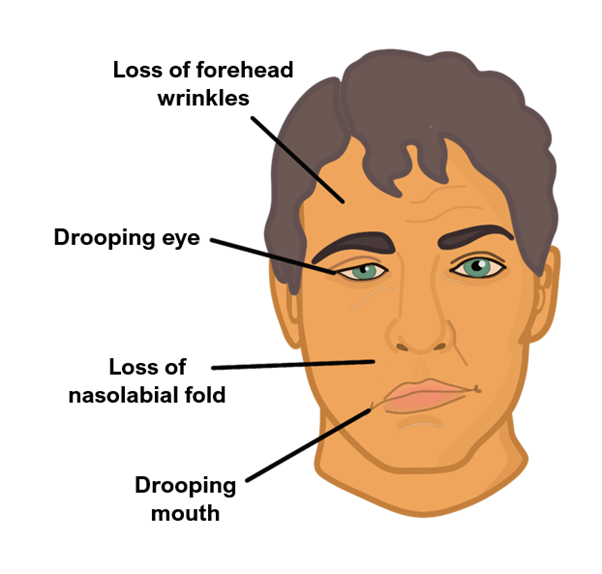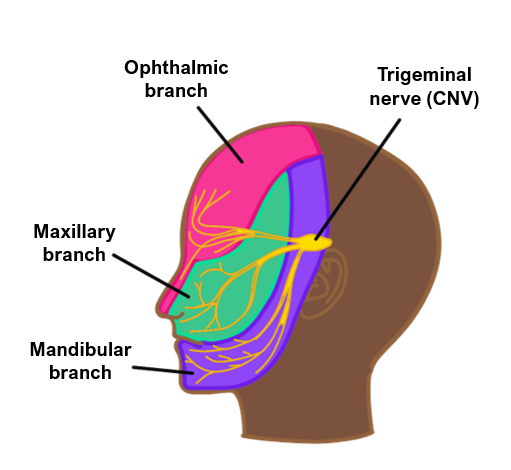Back to: Neurology
Specific Nerve Conditions
Bell’s Palsy
This is an idiopathic facial nerve palsy which causes lower motor neurone symptoms.
It is an acquired condition which is more prevalent in pregnant women and is more commonly seen below the age of 40.
Whilst idiopathic, it is often thought to be an inflammatory reaction following a viral infection and is also associated with diabetes mellitus.
Symptoms
Acute onset unilateral weakness of the whole face, including eyebrows, (stroke spares the forehead due to bilateral UMN innervation of the facial nerve nucleus)
Ipsilateral numbness and pain around the ear
Decreased taste, due to damage to the chorda tympani
Hypersensitivity to sounds (stapedius palsy)

Key tests
Blood tests to rule out infection
CT/MRI imaging to rule out tumours and stroke
Management
Prednisolone, should be given within 3 days of onset. Majority make full recovery.
Eye protection – eye patch and artificial tears to prevent drying
Ramsay Hunt Syndrome
This is a condition which occurs due to the reactivation of the varicella zoster virus in the geniculate ganglion of the facial nerve.
Symptoms
Ear pain followed by a painful rash in the auditory canal and pinna
Ipsilateral facial palsy – paralysis, loss of taste, deafness and dry mouth
Key tests
Blood test shows VZV antibodies
Blister fluid can be tested
Management
Acyclovir and prednisolone
Trigeminal Neuralgia
This is a painful syndrome of the trigeminal nerve which is characterised by acute-onset, and typically brief electric shock-like unilateral facial pain.
It is usually idiopathic, but can be caused by multiple sclerosis, tumours or contact with an abnormal or anatomically-variant blood vessel.
Causes
Usually idiopathic, but associated with MS and tumour

Symptoms
Facial pain, described as electric shock-like, coming on abruptly and going away quickly (< 1 minute)
Pain is in one of the three distributions of the trigeminal nerve branches
Light touch is a trigger for the pain e.g., washing/shaving/brushing teeth
Patient reports trigger areas (e.g., small areas around chin)
Management
1st line is carbamazepine, titrating up until the pain is relieved
If patient does not respond or the drug is contraindicated, refer to neurology for specialist treatment
Carpal Tunnel Syndrome
This refers to compression of median nerve in the carpal tunnel.
Symptoms
Tingling and numbness in palmar surface of lateral three and a half fingers
Weakness in LLOAF muscles (two lateral lumbricals, opponens policis, abductor pollicis brevis, flexor pollicis brevis)
Patient often shakes hands to relieve pain
Key tests
Usually a clinical diagnosis; EMG and nerve conduction studies can be performed
Management
Conservative management with night-time splint and physiotherapy
Definitive management is carpal tunnel surgery



